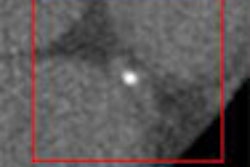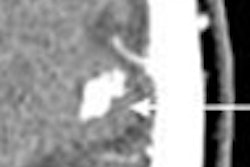The largest MR colonography (MRC) study of its kind to date showed high specificity, but disappointing per-polyp sensitivity, for a reduced-prep technique in patients in a low-prevalence population.
Still, most patients with significant polyps were identified, noted Dr. Jasper Florie and his colleagues from the Academic Medical Centre in Amsterdam, Netherlands.
Some CT colonography (CTC or virtual colonoscopy [VC]) studies have shown that a combination of low-fiber diet, an oral contrast agent for fecal tagging, and sometimes the addition of lactulose makes VC more patient-friendly, and the authors wanted to try a similar technique with MRC.
"For fecal tagging, either a bright-lumen strategy (gadolinium for fecal tagging and a water-gadolinium mixture for rectal filling) or a dark-lumen strategy (barium for tagging and water for rectal filling) can be used," the authors wrote. "Lactulose (a mild laxative) is used for stool softening and homogeneous contrast agent distribution." Barium is the cheaper strategy but reduces patient acceptance of the exam, they added (Radiology, March 2007).
They settled on a bright-lumen technique for the study. "No studies have been performed, to our knowledge, in these large patient populations with the use of bright-lumen MR colonography with fecal tagging, which is supposed to be a patient-friendly strategy primarily because it does not require radiation," Florie and colleagues wrote.
The researchers aimed to prospectively evaluate the diagnostic performance of MRC with limited bowel preparation for detecting polyps 10 mm and larger in a population with a personal or family history of colorectal cancer or adenomatous polyps.
Forty-eight hours before imaging, the 200 patients (mean age 58 years; 128 men, 41 with symptoms) restricted themselves to a low-fiber diet (only well-cooked, nonfibrous vegetables and meat, no fibrous fruit, and no whole-wheat cereal products or nuts) and ingested 12 g of lactulose powder (Centrafarm, Etten-Leur, Netherlands) dissolved in water. An oral contrast agent containing 10 mL of gadolinium (gadopentetate dimeglumine, Magnevist, Bayer Schering Pharma, Berlin) was added to major meals.
Butylscopolamine bromide (20 mg, Buscopan, Boehringer Ingelheim, Ingelheim, Germany) was administered as a spasmolytic agent, and the colon was distended with a mixture of water and gadolinium-based contrast to patient tolerance.
"This preparation renders the colonic lumen hyperintense on T1-weighted MR image and hypointense on T2-weighted images," the authors wrote.
The patients underwent T1- and T2-weighted MR imaging with either a 1.5- or 3-tesla system (Signa, GE Healthcare, Chalfont St. Giles, U.K.) or (Intera, Philips Medical Systems, Andover, MA), respectively, using phased-array coils.
Florie and his colleagues, Drs. Sebastiaan Jensche, Rutger Nievelstein, and Joep Bartelsman, used the following protocol: coronal 3D T1-weighted fast field-echo coronal and transverse 2D T2-weighted fast spin-echo sequences in both prone and supine positions. Multiple breath-holds were used to reduce imaging time per breath-hold, and free breathing was used for the T2-weighted images because too many short breath-holds would have been needed. Total room time was about 45 minutes.
The images were evaluated by two experienced observers using a dedicated PACS workstation, and the results were compared to optical colonoscopy, which served as the reference standard.
At colonoscopy ,12 of the 200 patients had 22 polyps 10 mm or larger. For these lesions MRC's per-patient sensitivity was 58% (7/12) for reader 1, 67% (8/12) for reader 2, and 75% (9/12) for both readers combined. Per-patient specificity was 95% (177/188) for reader 1, 97% (183/188) for reader 2, and 93% (175/188) for both readers combined.
Per-polyp sensitivity was just 55% (12/22) for reader 1, 50% (11/22) for reader 2, and 77% (17/22) for both readers combined, with interobserver agreement of 93% for identifying patients with lesions 10 mm or larger.
The sensitivity in this low-prevalence population was only "modest," although the specificity was high, the authors wrote, adding that the presence of only 22 polyps 10 mm or larger limited the sensitivity estimates.
The low sensitivity compared to other studies "could have been caused by the limited bowel preparation used," though it seems "an unlikely explanation because most polyps were visible and were not obscured by nontagged stool," they wrote. And although bowel motion, artifacts, and air bubbles could have complicated the exam, "studies of MR colonography performed with cleansing probably are hampered similarly," they wrote.
A more likely explanation is the higher disease prevalence in other populations studied, the group stated. Also, "dark-lumen MR colonography with intravenously administered gadolinium-based contrast has the theoretical advantage that polyps, including flat polyps, enhance and are thereby better visualized," the team wrote.
However, in an exploratory study, image quality with dark-lumen MRC fared no better than the present bright-lumen technique, and "bowel preparation with barium administered orally was considered burdensome, and a detriment to its possible use for screening in low-prevalence populations." And sensitivity for polyps smaller than 10 mm was even lower.
Although MRC with limited bowel prep might be a reasonable option for triaging patients in low-prevalence populations, "at present the sensitivity of this method is modest," Florie and his colleagues concluded. "We believe implementation of MR colonography in colorectal cancer screening has to await further technical improvements."
By Eric Barnes
AuntMinnie.com staff writer
March 6, 2007
Related Reading
MR colonography reveals significant extracolonic findings, February 14, 2007
MR colonography shows promise, with drawbacks, in diverticulitis, September 19, 2005
MR colonography finds most tiny rat lesions, October 8, 2004
Copyright © 2007 AuntMinnie.com



















